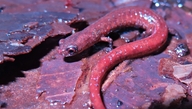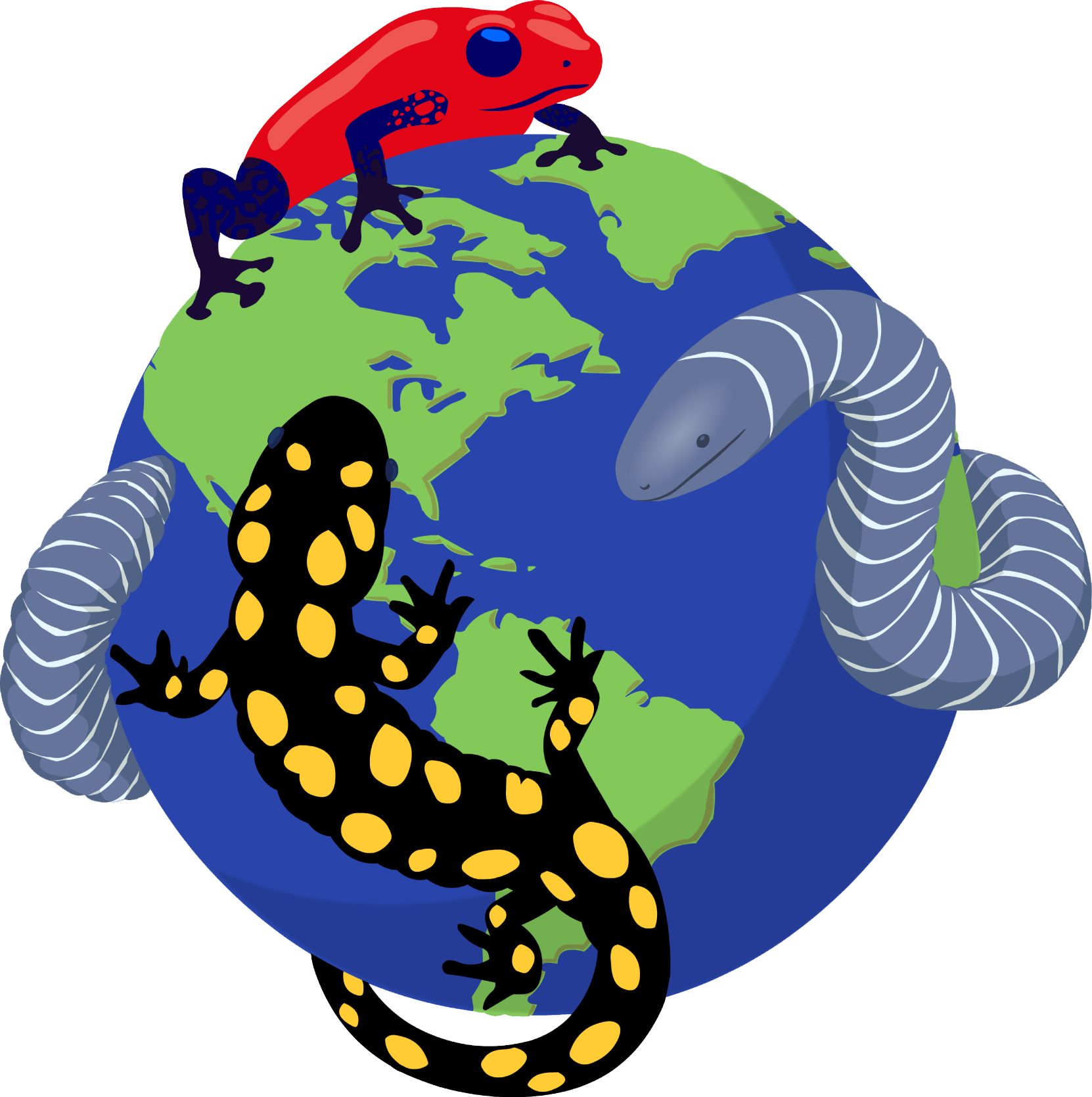|
Nototriton picadoi (Stejneger, 1911)
La Estrella Salamander, Picado's Moss Salamander Subgenus: Nototriton | family: Plethodontidae subfamily: Hemidactyliinae genus: Nototriton |
 © 2021 Juan G. Abarca (1 of 7) |
|
|
|
Description Previously, Nototriton matama (and N. major) were considered separate species but now are synonyms of N. picadoi (Kubicki et al 2022). The description for Nototriton matama: a small salamander described from four individuals. As adults, they have a snout-vent length of approximately 23.6 mm with a small, narrow head. Their short, wide snout has relatively large, elongated nostrils that are dorsally and anteriorly oriented. The eyes are large and prominent, appearing to protrude from the side of the head in the ventral view. There are swollen, oval parotoid glands that delineate the head from the relatively slender trunk. The tail is slender, tapering off before it breaks. The limbs are short, and the digits are basally webbed. The relative finger lengths are 1 < 4 < 2 < 3 and the relative toe lengths are 1 < 5 < 2 < 4 < 3 (Boza-Oviedo et al. 2012). The digits of this species are not fused and continue well past the basal interdigital webbing. The shortest digits have more blunt ends while the longest digits come to a more rounded end (Leenders 2016). Diagnosis: Nototriton picadoi is a robust salamander with large nostrils and a head of moderate length and width. This species was placed in the genus of Nototriton due to its well-developed sublingual fold, as well as having fewer than 17 vertebrae (Boza-Oviedo et al. 2012). Its legs are shorter than other members of the Nototriton genus. It has a thicker trunk and larger nostrils than similar species N. abscondens (Savage 2002). Some variation in overall size must be considered for this species as previous Nototriton matama was considered similar but smaller than N. picadoi, and it was thought that the two could be distinguished by N. matama’s smaller body size and wider feet (Leenders 2016). Coloration: The overall body color is brown. Irregular dorsolateral light yellow stripes are present from the occipital region and groin along the back and flanks (Savage 2002). In life, their dorsum is a dark golden brown with white and light brown stripes, while their tail is a golden brown. The parotoid glands are pale golden (Boza-Oviedo et al. 2012, Leenders 2016). They have a spotted design over their mouth that is white and black (Leenders 2016). The flanks are darker and speckled with brown speckles. There are lighter stripes bordering the ventral side of the flanks (Boza-Oviedo et al. 2012). In preservation, the body becomes an overall grey-brown to tan and there is a greater distinction between the light and dark parts of the body. The presence of white speckles was also seen on the species’ ventral side (Boza-Oviedo et al. 2012). Distribution and Habitat Country distribution from AmphibiaWeb's database: Costa Rica
It is suggested that the species is arboreal, as it prefers wet, mossy areas, limbs of trees, shrubs and bromeliads (Bruce 1998; Savage 2002; Wake and Good 1993). As N. matama, the species were mainly found in moss clumps (Leenders 2016). The species occupied different portions of the moss with some residing on moss near the stem of the plant, while others resided in moss found on the trunk and off of branches. For specimens found within the moss, the temperature was 16 - 17 C, while the surrounding air was 17 - 18 C (Boza-Oviedo et al. 2012). Life History, Abundance, Activity, and Special Behaviors Mating and egg laying occur during the wet season: May to December. However, the species may reproduce year round in areas where rainfall is sufficient during the dry season. Females lay several clutches throughout the season that consist of one to eleven eggs. Hatching occurs about 11-12 weeks after oviposition (Bruce 1999). Larva Coloration: Distinct patches of orange on the side of the head behind the eyes were observed. An orange stripe has been observed on the mid-dorsum. There are dorsolateral stripes absent of flecking and below these are areas of high flecking, which form a cream colored stripe (Bruce 1998). Trends and Threats Possible reasons for amphibian decline General habitat alteration and loss Comments Etymology: The species is named after Claudomiro Picado, who supplied the first observed specimen to Stejneger (Good and Wake 1993). Phylogenetic relationships: N. picadoi has been suspected to include synonyms as Bayesian Inference and Maximum Likelihood analyses of 16S and CytB have been poor resolved; N. picadoi and N. matama formed a polytomy, and a clade compose of N. abscondens and N. gamezi (Boza-Oviedo et al. 2012). A later study using Bayesian inference and maximum likelihood analyses on 16S, CytB, and COI sequences had consistent results (Arias and Kubicki 2018). Finally, Kubicki et al 2022, formally synonymized N. matama and N. major with N. picadoi.
References
Arias, E., Kubicki, B. (2018). “A new moss salamander, genus Nototriton (Caudata: Plethodontidae), from the Cordillera de Talamanca, in the Costa Rica-Panama border region.” Zootaxa, 4369(4), 487-500. [link] Boza-Oviedo, E., Rovito, S.M., Chaves, G., Garcia-Rodriguez, A., Artavia, L.G., Bolanos, F., Wake, D.B. (2012). ''Salamanders from the eastern Cordillera de Talamanca, Costa Rica, with descriptions of five new species (Plethodontidae: Bolitoglossa, Nototriton, and Oedipina) and natural history notes from recent expeditions.'' Zootaxa, 3309, 36 - 61. Bruce, R. C. (1998). ''Nesting habits, eggs and hatchlings of the salamander Nototriton picadoi (Plethodontidae: Bolitoglossini).'' Herpetological Monographs, 54, 13-18. Bruce, R. C. (1999). ''Life history attributes of a rare neotropical salamander, Nototriton picadoi (Plethodontidae: Bolitoglossini).'' Herpetological Review, 30, 76-78. Good, D. A., and Wake, D. B. (1993). ''Systematic studies of the Costa Rican moss salamanders, genus Nototriton, with descriptions of three new species.'' Herpetological Monographs, 7, 131-159. IUCN SSC Amphibian Specialist Group. (2020). "Nototriton matama." The IUCN Red List of Threatened Species 2020: e.T50927460A50927483. https://dx.doi.org/10.2305/IUCN.UK.2020-3.RLTS.T50927460A50927483.en. Accessed on 20 February 2022. Kubicki B, Reyes A, Arias E. (2022). "Revised taxonomy and distributions of Costa Rican moss salamanders (Caudata: Plethodontidae: Nototriton), with descriptions of new taxa." Zootaxa, 5194, 451–496. [link] Leenders, T. (2016). Amphibians of Costa Rica: a Field Guide. Comstock Publishing Associates, a division of Cornell University Press, Ithaca, New York. Savage, J. M. (2002). The Amphibians and Reptiles of Costa Rica:a herpetofauna between two continents, between two seas. University of Chicago Press, Chicago, Illinois, USA and London. Stuart, S., Hoffmann, M., Chanson, J., Cox, N., Berridge, R., Ramani, P., Young, B. (eds) (2008). Threatened Amphibians of the World. Lynx Edicions, IUCN, and Conservation International, Barcelona, Spain; Gland, Switzerland; and Arlington, Virginia, USA. Originally submitted by: Brooke Bivens, Alycia Fratzke, Diana Kimbrough (first posted 2009-11-02) Description by: Michelle S. Koo (updated 2022-11-11)
Distribution by: Michelle S. Koo (updated 2022-11-11)
Life history by: Michelle S. Koo (updated 2022-11-11)
Larva by: Michelle S. Koo (updated 2022-11-11)
Edited by: Mingna (Vicky) Zhuang, Michelle S. Koo (2022-11-11) Species Account Citation: AmphibiaWeb 2022 Nototriton picadoi: La Estrella Salamander <https://amphibiaweb.org/species/4093> University of California, Berkeley, CA, USA. Accessed Jun 15, 2025.
Feedback or comments about this page.
Citation: AmphibiaWeb. 2025. <https://amphibiaweb.org> University of California, Berkeley, CA, USA. Accessed 15 Jun 2025. AmphibiaWeb's policy on data use. |



 Raffaëlli Account
Raffaëlli Account Map of Life
Map of Life